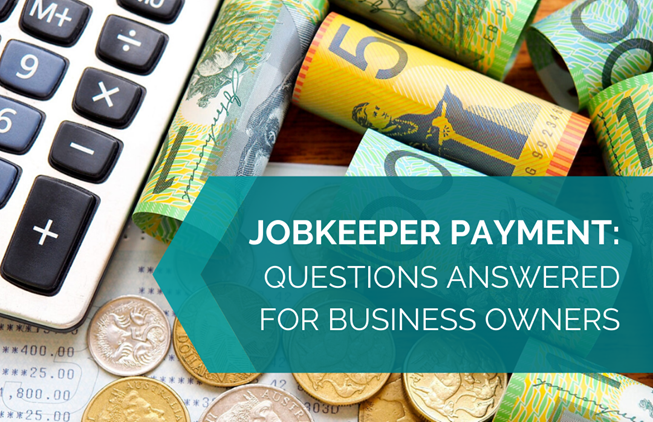
The $1,500 per fortnight per employee payment applies to most businesses with a turnover reduction of 30%, with payments commencing May 2020.
Legislation passed last week for the JobKeeper Payment providing employers with cashflow support to pay eligible employees for six months. While the ATO is expected to release more detail on the practical application of the new law, we have answered the following questions for business owners, to help you understand and action the necessary steps to be eligible:
- What is the JobKeeper Payment?
- Who is an eligible business for JobKeeper Payments?
- How does a business substantiate its decrease in turnover?
- Who is an eligible employee?
- Who is an eligible business participant?
- What does a business need to do to receive JobKeeper Payments?
- Need more information?
What is the JobKeeper Payment?
The JobKeeper payment is open to eligible employers to enable them to pay their eligible employee’s salary or wages of at least $1,500 (before tax) per fortnight.
Eligible employers will be reimbursed a fixed amount of $1,500 per fortnight for each eligible employee.
Employers will need to pay eligible employees a minimum of $1,500 (before tax) per fortnight to claim the JobKeeper payment. This will be paid to the employer in arrears each month by us. The first payments from the ATO to eligible employers will commence in the first week of May 2020. JobKeeper payments can be made in relation to wages paid to eligible employees from 30 March 2020.
If employers do not continue to pay their employees for each pay period, they will cease to qualify for the JobKeeper payment.
Who is an eligible business for JobKeeper Payments?
An eligible business is one that:
- On 1 March 2020, you carried on a business in Australia or were a not-for-profit organisation that pursued your objectives principally in Australia.
- You employed at least one eligible employee on 1 March 2020.
- Your eligible employees are currently employed by your business for the fortnights you claim for (including those who are stood down or re-hired).
- Your business has faced a:
- 30% decrease in turnover (for an aggregated turnover of $1 billion or less)
- 50% decrease in turnover (for an aggregated turnover of more than $1 billion), or
- 15% decrease in turnover (for ACNC-registered charities other than universities and schools)
Entities operating an eligible business include:
- sole traders
- partnerships
- trusts
- companies
There may be limitations on more than one business owner claiming JobKeeper payments. See information below on eligible employees and business participants.
How does a business substantiate its decrease in turnover?
For businesses with a turnover under $1 billion applying from the 30 March start date, you need to substantiate the 30% decrease in GST turnover for one of the following periods:
- Actual GST turnover for March 2020 compared to March 2019,
- Projected GST turnover for April 2020 compared to April 2019, or
- Projected GST turnover for the quarter April-June 2020 compared to quarter April-June 2019
GST turnover is likely to, but not necessarily equal to your total sales (item G1) on the BAS. ATO is expected to release more information on this.
You only need to satisfy this requirement once – you don’t need to retest turnover each month. If you work out that you qualify for the JobKeeper payments for the first fortnight because your turnover has declined by the relevant amount, you remain eligible and do not need to keep testing turnover in following months. However, you will have ongoing monthly reporting requirements. More information will be provided by the ATO soon.
Who is an eligible employee?
This is the primary category for eligibility for JobKeeper payments. Employees, including business owners, are eligible if, as at 1 March 2020, they:
- are employed (i.e. paid wages) by you, including those stood down or re-hired
- were either:
- a permanent full-time or part-time employee, or
- a long-term casual employee (employed on a regular and systematic basis for 12 months since 1 March 2019 and not a permanent employee of any other employer)
- were at least 16 years of age
- were an Australian resident, which requires that they reside in Australia, and are one of an Australian citizen, the holder of a permanent visa, or a Protected Special Category Visa Holder. Your employee can also be an Australian tax resident who is a Special Category (Subclass 444) Visa Holder. Employees who are not permanent residents of Australia must notify you of their visa status to allow you to determine if they are eligible.
- were not in receipt of any of these payments during the JobKeeper fortnight:
- government parental leave or Dad and partner pay
- a payment in accordance with Australian worker compensation law for an individual’s total incapacity for work
- agree to be nominated by you via a nomination notice. If your employees have multiple employers, they can usually choose which employer they want to nominate through. However, if your employees are long-term casuals and have other permanent employment, they must choose the permanent employer and cannot nominate you. They cannot receive the JobKeeper payment from more than one employer.
You cannot claim for any employees who:
- were first employed by you after 1 March 2020, or
- left your employment before 1 March 2020, or
- have been, or have agreed to be, nominated by another employer.
Employees who have been stood down from work under the Fair Work Act 2009 without pay may still be eligible employees as long as they were in your employment and met the eligibility criteria on 1 March 2020.
You will need to have paid eligible employees at least the minimum amount of $1,500 for each fortnight you claim for, to receive the JobKeeper payment. If an eligible employee usually earns less than $1,500 per fortnight, the business must increase their gross wage to $1,500 per fortnight. Superannuation guarantee is not required to be paid on the uplift paid.
If a business is claiming JobKeeper for an eligible employee from 30 March, it must ensure the minimum $1,500 per fortnight (or equivalent wage for the normal pay run period) is paid in full before the end of 30 April or that employee will not be an eligible employee.
If you terminated an employee after 1 March 2020, you can re-engage them and they will be eligible if they met the eligibility criteria on 1 March 2020. If you want to claim the JobKeeper payment for employees you have re-engaged, you will need to:
- confirm they want to be re-hired and participate in the JobKeeper scheme with you
- re-engage the employees you want to claim for
- ask them to complete the nomination notice and return it to you. You are required to keep this form as part of your records keeping obligations under the law
- start paying them a minimum of $1,500 (before tax) for each fortnight they are employed and you claim for.
Who is an eligible business participant?
This is the secondary category for eligibility for JobKeeper payments relating to non-employee individuals. It is available to sole traders, partnerships, trusts and companies, but limited to one $1,500 JobKeeper payment per fortnight for one eligible business participant.
Your entity is eligible if:
- on 1 March 2020, it carried on a business in Australia
- it satisfies the decrease in turnover test for a relevant period (detailed above)
- it had an ABN on 12 March 2020, and
- it had lodged, on or before 12 March 2020, at least one of:
- a 2018–19 income tax return showing that it had an amount included in its assessable income in relation to it carrying on a business, or
- an activity statement or GST return for any tax period that started after 1 July 2018 and ended before 12 March 2020 showing that it made a taxable, GST-free or input-taxed sale.
- Note: A discretion to give further time after 12 March 2020 may apply in limited circumstances. More information will be available soon.
A business participant is eligible for a JobKeeper payment if, as at 1 March 2020, your entity has a non-employee individual:
- who is actively engaged in the operation of the business, as one of the following:
- a sole trader
- a partner in the partnership
- an adult beneficiary of the trust
- a shareholder or director in the company
- aged at least 16 and an Australian resident (within the meaning of section 7 of the Social Security Act 1991), or a resident for income tax purposes and the holder of a special category (Subclass 444) visa
- not currently receiving government parental leave pay, dad and partner pay
- not currently totally incapacitated for work and receiving payments under an Australian workers’ compensation law in respect of your total incapacity to work
- not an employee (other than a casual employee) of another entity
- they have given you a JobKeeper nomination notice, and not given another entity a JobKeeper nomination notice.
JobKeeper payments for business participants aren’t required to be paid to the individual and can be retained within the business (unlike those for employees).
What does a business need to do to receive JobKeeper Payments?
From today, action the following steps:
- Step 1 – Register your interest with the ATO and subscribe for JobKeeper payment updates.
- Step 2 – Check you and your employees meet the eligibility requirements.
- Step 3 – Continue to pay at least $1,500 to each eligible employee per JobKeeper fortnight (the first JobKeeper fortnight is the period from 30 March to 12 April). Any catch-up payments need to be paid by the end of April. See “who is an eligible employee” above for more details.
- Step 4 – Notify your eligible employees that you are intending to claim the JobKeeper payment on their behalf and check they aren’t claiming JobKeeper payment through another employer or have nominated through another business.
- Step 5 – Send the JobKeeper employee nomination notice to your nominated employees to complete and return to you by the end of April if you plan to claim JobKeeper payment for April. Keep it on file and provide a copy to your registered tax agent if you are using one.
From Monday, 20 April, the enrolment form will be available from the ATO
- Step 6 – From 20 April 2020, you can enrol with us for the JobKeeper payment using the Business Portal and authenticate with MyGovID. You must do this by the end of April to claim JobKeeper payments for April. If you are not setup with a MyGovID, contact your Altitude adviser to assist you with enrolment.
- The form will require you to provide:
- bank details for payments
- specify the estimated number of employees who will be eligible for the first JobKeeper fortnight (30 March – 12 April) and the second JobKeeper fortnight (13 April – 26 April)
- indicate if you are claiming an entitlement based on business participation
From Monday, 4 May, the first claim form will be available from the ATO. Details of the form will follow in due course.
Need more information?
Please refer to the following Australian Taxation Office website for more information as it is released: https://www.ato.gov.au/General/JobKeeper-Payment/
Please refer to the following Treasury department fact sheets for more information, including examples of how ‘JobKeeper’ will apply:
- For employers: JobKeeper Payment – Information for Employers
- For employees: JobKeeper Payment – Information for employees
Frequently Asked Questions: JobKeeper payment – Frequently asked questions
If you have any questions regarding JobKeeper and how it applies to you, please do not hesitate to contact your Altitude Adviser. We are here to help.


